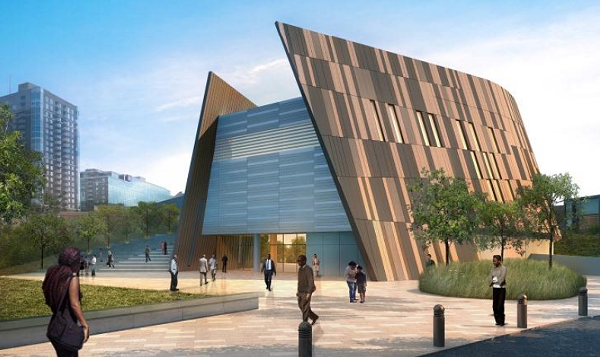
The 1955 Montgomery Bus Boycott in Alabama — initiated by Rosa Parks and held together by Rev. Martin Luther King Jr. — may be recognized as the official start of the modern Civil Rights Movement, but the “movement” was really born in the city of Atlanta.
Atlanta is not only the birthplace of the movement’s most recognizable and iconic figure, King, but it was and continues to be considered the mecca of black intellectualism and success.
On Monday, June 23, the Center for Civil and Human Rights opens to the public, and the Atlanta Daily World will identify the 7 things you should know about the center as you plan to take you trip to the institution:
1. CCHR has as its immediate neighbors in the Pemberton Place tourist mecca are the World of Coke and the Georgia Aquarium; nearby are Centennial Olympic Park and the CNN Center.
2. Exhibitions director David Mandel said the average visitor — the “stroller” — will spend 75 minutes at the center. All tours are self-guided and will take visitors to any or all of three galleries.
3. Rolls Down Like Water: The American Civil Rights Movement. This gallery was curated by George C. Wolfe, a Tony Award-winning playwright and director, best-known for directing “Bring in ‘da Noise/Bring in ‘da Funk” and “Angels in America — Millennium Approaches.”
4. Visitors enter this gallery on the second floor of the 42,000-square-foot center. They walk through a compact anteroom papered with everyday scenes from the pre-civil rights era.
5. Then visitors pass through the first of what Wolfe calls “portals,” or defining moments, in this case the Brown v. Board of Education decision. This ushers them into a wash of sound and video.
Here visitors will see films of police dogs attacking protesters, a wall-sized photo of a baby-faced Emmett Till, a life-size re-creation of a Freedom Rider bus, covered with portraits of actual Freedom Riders.
6. In the next room, a panoramic screen tells the story of the 1963 March on Washington on Aug. 28.
Then, just two week that euphoric moment on the steps of the Lincoln Memorial before 250,000 people, four young girls were killed in the Birmingham, Ala. church bombing. The exhibit also includes the day, April 4, 1968 when MLK was murdered in Memphis, Tenn. Visitors will also Walter Cronkite — who famously announced the assassination of President Kennedy while fighting back tears — announcing King’s death on national television. Visitors can also walk up a staircase illuminated by the re-creation of the sign outside the Lorraine Motel in Memphis, Tenn.
7. In the last room, a different set of laws is inscribed on the walls: laws banning segregation and guaranteeing equal rights for all Americans, laws that were passed as a result of the massive freedom movement.
